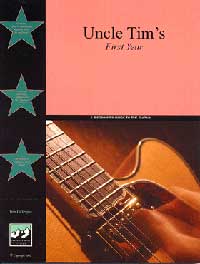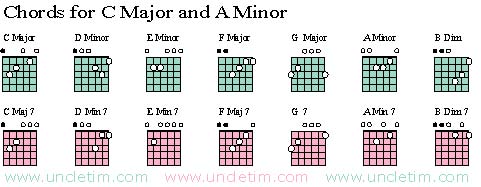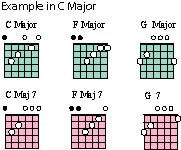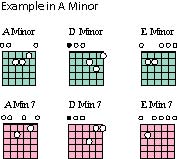

If You Are Going To Play In A Key Every Day, Shouldn't You Learn That Way?
Yes, you should!
Music is key based. You are always in one key or another. Always!
Yet playing a guitar is not taught that way! Why?
Once you understand keys and the chords and scales that come from keys, the whole world of music opens up before your eyes!
Suddenly everything is MUCH easier. And it totally makes sense when you get into it.
For $15, you can put this all to rest right now. Pick up a copy today.
eBooks are delivered instantly!
by Tim Gillespie
This month the exercises are easy. All we are trying to focus on is exploring the two different tonal centers locked inside a scale.
As usual we will use the C major and A minor scale. We are going to match the notes against the chords available within the key. This will allow you to choose any combination of chords and construct a simple song.
Having two players is very helpful for this, but it can be done nicely alone with a tape or digital recorder.
First set up a chord line using some of these chords. You can set up your own progression or use the simple example below.

For the sake of ease, here is an example of a simple 1, 4, 5 progression you can use to give this a try.
Try it in the key of C major first.


So just remember to get in a steady jam that stays consistent and allows for a rhythm to show up.
Then play the C scale over it and notice how you can build a solo easily. If you have been playing through the examples in past columns, you should be quite familiar with this.
Okay, did you feel the sense of the key, playing these elements together provides?
Now let's try it with the A minor chords. Same 1, 4, 5 progression, just working inside the key of A minor instead.

 So
now we are setting up the same progression. If you used substitutions
in the last example, use the same ones again. When we set this up we want
to keep everything the same other than the key. You will put other things
together if we do this.
So
now we are setting up the same progression. If you used substitutions
in the last example, use the same ones again. When we set this up we want
to keep everything the same other than the key. You will put other things
together if we do this.
Now try to put a lead down. You can play the same string of notes and try to make them fit, or you can play something else entirely. I would try both.
Playing the exact same thing, in a different key, makes you adjust to the rhythm of the song. After all if you use the same notes at the same place, you will find they do not work the same way they did in the major key. Now when you arrive at the C note, it does not bring the piece to rest. Instead you have to deal with being at the wrong place at the wrong time.
As you work through this, you will begin to modulate to the A note instead of C. I use the term modulate because that is what you are doing. Playing the C major scale is different than playing the A minor scale. If you look at it in terms of modes, you are playing in different modes. The C major scale is characterized by the Ionian mode. This mode uses the exact sequence of notes C, D, E, F, G, A, B.
The A minor scale uses the Aeolian mode of the C major scale, which is A, B, C, D, E, F, G. In that exact order.
When you do this exercise and play in the two different keys, you will notice that you start to modulate towards whichever note is serving as tonic (keynote). If it is the key of A minor, you will start to orient yourself towards starting and ending the lead with the note of A. If you are working out of the C major key, you will gravitate towards using the C note to bring the piece to rest. There is more to modulation than that, but this exercise should give you a little sense of it.
A Major Tonal Center And A Minor One.
There is one other very important thing to get out of this exercise. Notice that when you play through the two keys you get two different tonal centers. The notes and chords really do center around the two keynotes. But did you notice that the major tonal center is stronger than the minor one?
Try this again only this time think about how strong the tonal center sounds.
I can easily hear that I have to work a little harder to keep the minor progression together enough so it sounds like a key. It is a little easier to do this in the major key!
If you are well versed in playing in minor keys, then you are probably very sensitive to the minor key and sound. You may have already adapted to hearing this minor tonal center. But for people new to this, this is a great time to make sure you pick up on the fact the minor key is not as strong as the major one.
Don't think it is any lesser for the minor qualities. Minor keys are
unique to themselves and have their own personalities. They are strong
tonal centers to be sure.